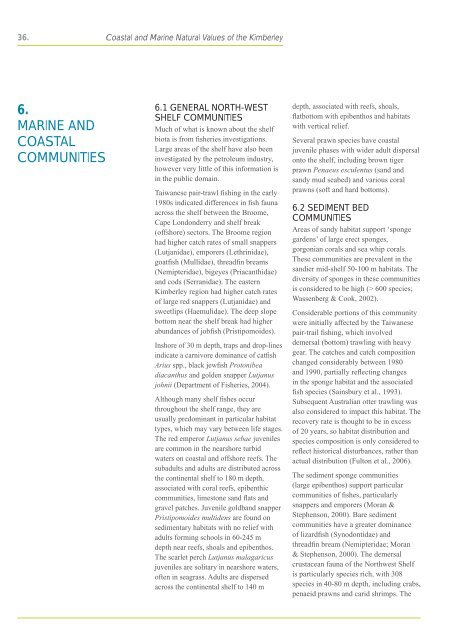coastal and marine natural values of the kimberley - wwf - Australia
coastal and marine natural values of the kimberley - wwf - Australia
coastal and marine natural values of the kimberley - wwf - Australia
Create successful ePaper yourself
Turn your PDF publications into a flip-book with our unique Google optimized e-Paper software.
36. Coastal <strong>and</strong> Marine Natural Values <strong>of</strong> <strong>the</strong> Kimberley6.MARINE ANDCOASTALCOMMUNITIES6.1 GENERAL NORTH-WESTSHELF COMMUNITIESMuch <strong>of</strong> what is known about <strong>the</strong> shelfbiota is from fisheries investigations.Large areas <strong>of</strong> <strong>the</strong> shelf have also beeninvestigated by <strong>the</strong> petroleum industry,however very little <strong>of</strong> this information isin <strong>the</strong> public domain.Taiwanese pair-trawl fishing in <strong>the</strong> early1980s indicated differences in fish faunaacross <strong>the</strong> shelf between <strong>the</strong> Broome,Cape Londonderry <strong>and</strong> shelf break(<strong>of</strong>fshore) sectors. The Broome regionhad higher catch rates <strong>of</strong> small snappers(Lutjanidae), emporers (Lethrinidae),goatfish (Mullidae), threadfin breams(Nemipteridae), bigeyes (Priacanthidae)<strong>and</strong> cods (Serranidae). The easternKimberley region had higher catch rates<strong>of</strong> large red snappers (Lutjanidae) <strong>and</strong>sweetlips (Haemulidae). The deep slopebottom near <strong>the</strong> shelf break had higherabundances <strong>of</strong> jobfish (Pristipomoides).Inshore <strong>of</strong> 30 m depth, traps <strong>and</strong> drop-linesindicate a carnivore dominance <strong>of</strong> catfishArius spp., black jewfish Protonibeadiacanthus <strong>and</strong> golden snapper Lutjanusjohnii (Department <strong>of</strong> Fisheries, 2004).Although many shelf fishes occurthroughout <strong>the</strong> shelf range, <strong>the</strong>y areusually predominant in particular habitattypes, which may vary between life stages.The red emperor Lutjanus sebae juvenilesare common in <strong>the</strong> nearshore turbidwaters on <strong>coastal</strong> <strong>and</strong> <strong>of</strong>fshore reefs. Thesubadults <strong>and</strong> adults are distributed across<strong>the</strong> continental shelf to 180 m depth,associated with coral reefs, epibenthiccommunities, limestone s<strong>and</strong> flats <strong>and</strong>gravel patches. Juvenile goldb<strong>and</strong> snapperPristipomoides multidens are found onsedimentary habitats with no relief withadults forming schools in 60-245 mdepth near reefs, shoals <strong>and</strong> epibenthos.The scarlet perch Lutjanus malagaricusjuveniles are solitary in nearshore waters,<strong>of</strong>ten in seagrass. Adults are dispersedacross <strong>the</strong> continental shelf to 140 mdepth, associated with reefs, shoals,flatbottom with epibenthos <strong>and</strong> habitatswith vertical relief.Several prawn species have <strong>coastal</strong>juvenile phases with wider adult dispersalonto <strong>the</strong> shelf, including brown tigerprawn Penaeus esculentus (s<strong>and</strong> <strong>and</strong>s<strong>and</strong>y mud seabed) <strong>and</strong> various coralprawns (s<strong>of</strong>t <strong>and</strong> hard bottoms).6.2 SEDIMENT BEDCOMMUNITIESAreas <strong>of</strong> s<strong>and</strong>y habitat support ‘spongegardens’ <strong>of</strong> large erect sponges,gorgonian corals <strong>and</strong> sea whip corals.These communities are prevalent in <strong>the</strong>s<strong>and</strong>ier mid-shelf 50-100 m habitats. Thediversity <strong>of</strong> sponges in <strong>the</strong>se communitiesis considered to be high (> 600 species;Wassenberg & Cook, 2002).Considerable portions <strong>of</strong> this communitywere initially affected by <strong>the</strong> Taiwanesepair-trail fishing, which involveddemersal (bottom) trawling with heavygear. The catches <strong>and</strong> catch compositionchanged considerably between 1980<strong>and</strong> 1990, partially reflecting changesin <strong>the</strong> sponge habitat <strong>and</strong> <strong>the</strong> associatedfish species (Sainsbury et al., 1993).Subsequent <strong>Australia</strong>n otter trawling wasalso considered to impact this habitat. Therecovery rate is thought to be in excess<strong>of</strong> 20 years, so habitat distribution <strong>and</strong>species composition is only considered toreflect historical disturbances, ra<strong>the</strong>r thanactual distribution (Fulton et al., 2006).The sediment sponge communities(large epibenthos) support particularcommunities <strong>of</strong> fishes, particularlysnappers <strong>and</strong> emporers (Moran &Stephenson, 2000). Bare sedimentcommunities have a greater dominance<strong>of</strong> lizardfish (Synodontidae) <strong>and</strong>threadfin bream (Nemipteridae; Moran& Stephenson, 2000). The demersalcrustacean fauna <strong>of</strong> <strong>the</strong> Northwest Shelfis particularly species rich, with 308species in 40-80 m depth, including crabs,penaeid prawns <strong>and</strong> carid shrimps. The
















